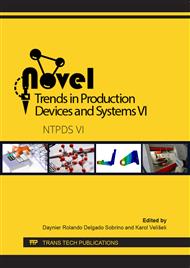p.223
p.232
p.240
p.248
p.256
p.265
p.272
p.280
p.288
Numerical Simulation of Forging Process in Deform 3D
Abstract:
The main purpose of this contribution is to create a methodical procedure for numerical simulation of the forging process using FEM of a real part, which is produced in three forming operations. Then this process will be realised step by step for creation simulation model in the simulation software DEFORM 3D, where the output data will be calculated on an example forging process on real component. The obtained results are then compared with reality to determine the degree of match between simulation results and real component. The 3D models of dies for each operation as well as some input parameters were obtained from HKS Forge. This company is leading manufacturer of die forging for the engineering industry in Europe. Proposed methodical procedure can serve as a basis for creating additional simulation models that could simulate the wear of these dies during long time of use.
Info:
Periodical:
Pages:
256-264
Citation:
Online since:
May 2020
Authors:
Keywords:
Price:
Сopyright:
© 2020 Trans Tech Publications Ltd. All Rights Reserved
Share:
Citation:


